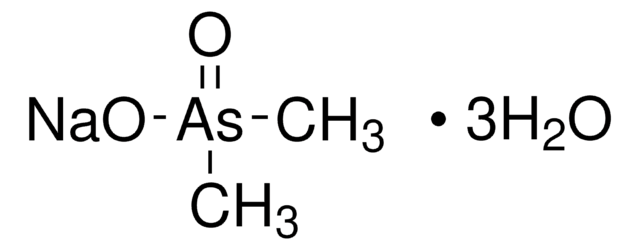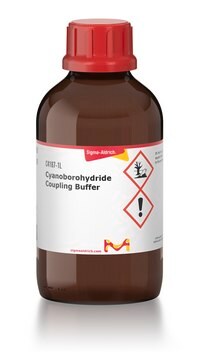G7651
グルタルアルデヒド 溶液
Grade I, 50% in H2O, specially purified for use as an electron microscopy fixative or other sophisticated use
別名:
グルタル酸ジアルデヒド 溶液, ペンタン-1,5-ジオール
About This Item
おすすめの製品
品質水準
タイプ
Grade I
形状
liquid
濃度
50% in H2O
テクニック
electron microscopy: suitable (fixative)
色
colorless
mp
-21 °C ((-6 °F))
溶解性
water: soluble
輸送温度
dry ice
保管温度
−20°C
SMILES記法
[H]C(CCCC([H])=O)=O
InChI
1S/C5H8O2/c6-4-2-1-3-5-7/h4-5H,1-3H2
InChI Key
SXRSQZLOMIGNAQ-UHFFFAOYSA-N
類似した製品をお探しですか? 訪問 製品比較ガイド
詳細
アプリケーション
- 4-(2-ヒドロキシエチル)-1-ピペラジンエタンスルホン酸(HEPES)バッファーと共に、走査電子顕微鏡(SEM)用にコンカナバリンA上に濃縮細胞外小胞(EV)を固定するため
- 細胞を形態観察のために固定するための溶液中の成分として
- 細菌性細胞の表面形態を保存するために水溶液中に大腸菌細胞を固定するため
生物化学的/生理学的作用
特徴および利点
- レンズが付いたゴム製またはプラスチック製の機器と高効率かつ安全に使用できます
- 金属腐食性なし
- 最短保存可能期間は14日
免責事項
シグナルワード
Danger
危険有害性の分類
Acute Tox. 3 Inhalation - Acute Tox. 4 Oral - Aquatic Acute 1 - Aquatic Chronic 2 - Eye Dam. 1 - Resp. Sens. 1 - Skin Corr. 1B - Skin Sens. 1 - STOT SE 3
ターゲットの組織
Respiratory system
補足的ハザード
保管分類コード
6.1A - Combustible acute toxic Cat. 1 and 2 / very toxic hazardous materials
WGK
WGK 3
引火点(°F)
Not applicable
引火点(℃)
Not applicable
適用法令
試験研究用途を考慮した関連法令を主に挙げております。化学物質以外については、一部の情報のみ提供しています。 製品を安全かつ合法的に使用することは、使用者の義務です。最新情報により修正される場合があります。WEBの反映には時間を要することがあるため、適宜SDSをご参照ください。
PRTR
第一種指定化学物質
労働安全衛生法名称等を表示すべき危険物及び有害物
名称等を表示すべき危険物及び有害物
労働安全衛生法名称等を通知すべき危険物及び有害物
名称等を通知すべき危険物及び有害物
Jan Code
G7651-10X10ML:4548173952536
G7651-BULK:
G7651-VAR:
G7651-10ML:4548173952529
この製品を見ている人はこちらもチェック
ライフサイエンス、有機合成、材料科学、クロマトグラフィー、分析など、あらゆる分野の研究に経験のあるメンバーがおります。.
製品に関するお問い合わせはこちら(テクニカルサービス)







